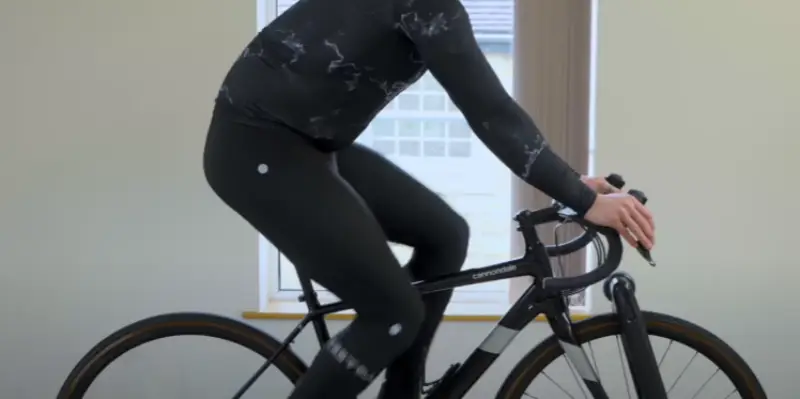When you create space between your vertebrae, you’re letting your muscles relax. This stretches or lengthens the muscles around the neck, leading to improved mobility, range of motion, and alignment.
Use a foam roller for a W stretch (this will loosen up tight shoulders and pecs). Exercises to stretch the last (combine these with ultra-deep breathing to get deep into the muscles). You should always stretch your neck while seated (be very gentle but do not skip this if you suffer from cycling-related tension).
This article explains the best ways to decompress your neck after cycling and is here to guide you through some efficient exercises.
How To Decompress Neck After Cycling: 9 Best Moves

Bike riding is great for keeping fit and enjoying the outdoors, but it can cause neck pain or tension, especially if you spend long hours on the bike. Proper post-ride care is essential to prevent and ease any neck issues that may arise. Here are some tips on how to decompress your neck after cycling:
Ensure Proper Bike Fit
An improper bike fit is one of the primary reasons for neck discomfort during or after cycling. If your bike is not adjusted to your body proportions, it could strain your neck muscles. Ensure the saddle height, handlebar reach, and handlebar height are all set correctly to allow for a more comfortable riding position.
Maintain a Correct Posture
Make sure you’re sitting up straight while you ride. Keep your back straight, your shoulders relaxed, and your head in a neutral position facing forward. Avoid hunching over the handlebars or craning your neck upward for extended periods. Good posture while cycling can help ease the stress on your neck muscles.
Take Rest Breaks
If you embark on a long cycling journey, stop regularly to stretch and rest your muscles. Dismounting from the bike and performing gentle neck stretches and shoulder rolls can help release tension that may have built up during your ride. Listen to your body’s signals, and don’t push through discomfort.
Use Heat Therapy
Heat therapy can relieve tight muscles and increase blood flow in the affected area. Consider applying a warm compress or a hot shower to help ease neck tension after cycling. However, be cautious not to use excessive heat, which can lead to burns or skin irritation.
Incorporate Massage

Massage therapy can work wonders for releasing tension in your neck muscles. You can opt for a professional massage from a licensed therapist or perform self-massage techniques at home using gentle kneading motions on the neck and shoulders. Be careful not to apply too much pressure to avoid exacerbating discomfort.
Stay Hydrated
Proper hydration is crucial for overall muscle health and recovery. Remember to drink adequate water before, during, and after your cycling sessions to prevent dehydration, which can contribute to muscle stiffness and cramping. Hydration supports optimal muscle function and can aid in reducing post-exercise soreness.
9 Best Exercises For Decompressing Your Neck After Cycling
After a long cycling session, taking care of your neck, which often endures the strain, is crucial. Neck decompression exercises can help ease tension and discomfort. Here are some practical exercises you can decompress your neck after cycling:
Neck Tilts
Neck tilts are a simple yet effective way to release neck tension. Start by sitting or standing up straight. When you tilt your head towards one shoulder, feel a gentle stretch on the other side of your neck. Take a few seconds to hold this position before returning to the center. Repeat on the other side.
Chin Tucks
Chin tucks help strengthen the muscles that support good posture while relieving strain on the neck. Begin by seated or standing straight. Gently pull your chin into your chest without moving your head forward. Return to the starting position after a few seconds. Repeat several times.
Foam Rolling
Foam rolling can be beneficial for releasing tightness in the neck and upper back. The foam roller should be positioned under your neck. Using slow rolling movements, target any tension areas. Be gentle and avoid excessively pressuring the neck.
Side of Neck Decompression
To decompress the side of your neck, sit or stand up straight. Hold one hand on one side of your head and gently tilt your head towards the opposite shoulder until your neck stretches. Hold for a few seconds, and then switch sides.
Back of Neck Decompression
This exercise targets the back of your neck. Sit or stand with your spine aligned. Lie on your side with your hands at the base of your skull and interlace your fingers. Apply gentle pressure as you tuck your chin towards your chest. Hold for a moment before releasing.
Decompression with Towel

A towel can be used for neck decompression. Roll up a towel and place it under your neck while lying down. Allow your neck to relax over the towel, feeling a gentle stretch. Breathe deeply and hold this position for a minute or two.
Neck Decompression with Hands
Sit comfortably and bring one hand over your head, placing it on the opposite ear. Gently pull your head towards the shoulder, using the weight of your hand to create a stretch along the side of your neck. Hold for a few breaths and switch sides.
Self Neck Traction (Lying Down)
Lie down on your back with a small cushion under your head for support. Place your hands behind your head and gently lift your head off the ground, aiming to lengthen your neck. Hold for a few seconds before lowering your head back down.
Neck Traction with Band
Using a resistance band for neck traction can achieve a deeper stretch. Sit on the floor with your legs extended. Wrap the band around a sturdy object and loop it around the back of your head. Slowly lean back, allowing the band to create traction on your neck.
Conclusion
We’ve discussed why neck discomfort can arise from cycling and how to prevent it with proper bike change, correct posture, regular breaks, heat therapy, massage, and hydration. We’ve also walked you through 9 exercises to help you decompress your neck after a cycling session.
Remember, your body is your most important piece of cycling equipment. Taking care of it, especially your neck, which bears the strain of rides, is crucial for sustaining your passion for cycling. So, next time you finish a ride, consider these tips for neck decompression.
FAQs
How long does neck decompression last?
The typical spinal decompression treatment protocol comprises 12 to 20 sessions spread over four to six weeks. Some conditions require fewer visits, while others need more.
How do you sleep to decompress your neck?
Use a pillow to support your neck and ensure your head is neutral. If you sleep on your back, buy a memory foam or down pillow to help your head conform to its shape. A foam pillow with an indentation may be more comfortable if you sleep on your side.


